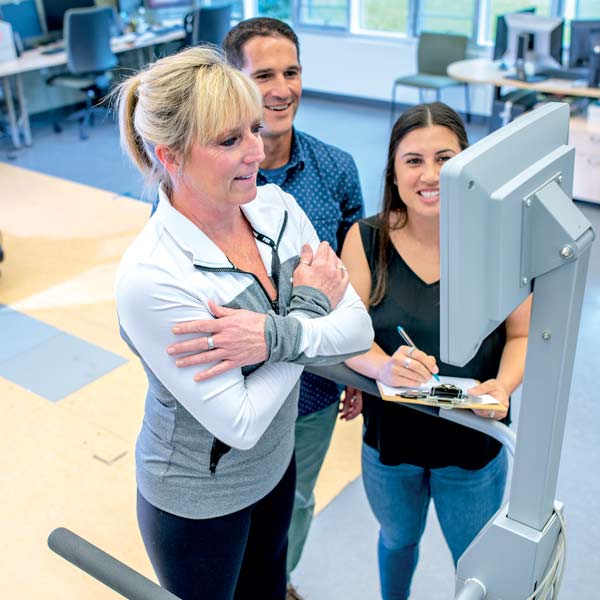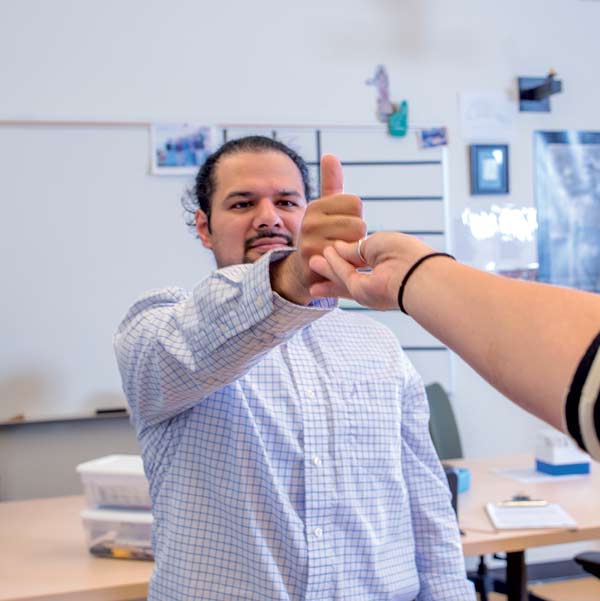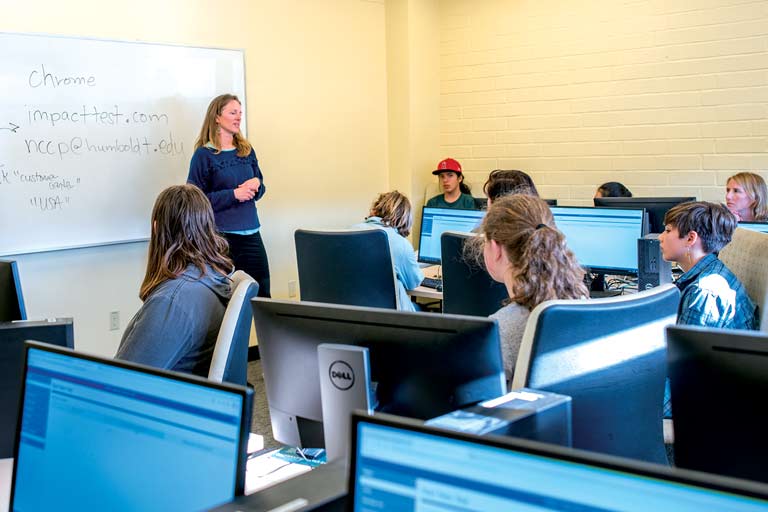Getting Back in the Game
Humboldt Concussion Program continues and expands its work
The study improved concussion assessments, showing that a combined approach of evaluating symptoms, neurological status, and balance is the most effective way to evaluate concussion status.
•••
By Grant Scott-Goforth
Erica McMullen is a competitive person. She logged thousands of minutes of playtime as defender on HSU’s Women’s Soccer Team, starting more than two dozen games.
She also suffered three concussions,—all during games—between 2012 and 2015. The symptoms ranged from pain and sensitivity to light to cognitive issues—and she was unable to attend classes after her final concussion.
"Sitting out was not something I was ever used to," she says.
BECAUSE OF THOSE INJURIES, McMullen was an early participant in HSU’s North Coast Concussion Program (NCCP), which began in 2010 and expanded in 2015. Today, the program is still going strong as HSU joins a massive national effort to improve the understanding, diagnosis of and recovery from concussions, while preparing HSU students for careers and serving thousands of college and high school athletes and community members.
At its most basic, the NCCP has two functions: research and service. Program staff and students provide education and best practice care to students and community members. They invite student-athletes and local community members for baseline testing that provides a sense of their cognitive functioning. Working with the University’s NCAA athletes, the program collects data on concussions—causes, diagnoses, and recovery—refining the tests that help them evaluate the injuries, and contributing that information to the national study.
Late last year, the concussion program was awarded an additional $250,000 by the NCAA and Department of Defense as part of a national study called the CARE Consortium to continue its research on college athletes. Since 2015, the CARE Consortium has seen dozens of universities collect data on more than 50,000 athletes and military cadets, the largest concussion study in history. The program finds other ways to pay for community testing, education, and service.
Study data collected by the consortium indicates that athletes who are removed from play immediately after a concussion injury return to play roughly two days faster than those who continue to play. The study also revealed that attitudes among student-athletes, medical providers, and athletic programs have changed, increasing the average recovery time and eliminating repeat concussions within 10 days of the original injury.
The study has also improved concussion assessments, showing that a combined approach of evaluating symptoms, neurological status, and balance is the most effective way to evaluate concussion status.
In the process of conducting research, HSU students who work on the study gain valuable experience. A Kinesiology major who wanted to become an athletic trainer, McMullen was invited to intern with NCCP and liked the idea of giving tailored one-on-one care to athletes. Her internship sparked a new interest—hands-on care of assessing concussion symptoms combined with gathering data for the largest study of its kind.
"The combination is what made me love it so much. Seeing academic papers from the CARE Consortium—the work you’re doing—it’s really rewarding," says McMullen, who graduated in 2016 and is currently the NCCP’s Research Coordinator.
HSU is a great feeder school. We're known for high-level research, service, and collaborations, as well as hands-on skills that graduates need for successfully conducting these kinds of interdisciplinary, multidimensional projects. ~ Justus Ortega, professor of Kinesiology
Justus Ortega, an HSU Kinesiology professor and director of the North Coast Concussion Program, says many students who worked for the HSU Concussion Program have gone on to prestigious graduate programs and medical schools.
"HSU is a great feeder school," he says. "We're known for high-level research, service, and collaborations, as well as hands-on skills that graduates need for successfully conducting these kinds of interdisciplinary, multidimensional projects."
The other function of NCCP, led by the program's Service Coordinator Beth Larson, is educating the community and reaching out to additional sectors that may benefit from testing.
First intended for intercollegiate student-athletes at HSU, College of the Redwoods, and several local high schools, the concussion program has expanded testing for club athletes, all high school athletes in Humboldt and Del Norte counties, first responders, and others who've suffered concussions or are at risk. This, combined with information on best practices with local educators and healthcare professionals, has made it an important resource on the North Coast.
In the meantime, HSU's groundbreaking concussion program has expanded the scope of research by applying lessons across the CSU system.
After a visit from CSU Chancellor Timothy White, Ortega says they began the CSU Concussion Initiative; a collaborative program of assessing concussion protocols throughout the entire university system and consulting other CSU campuses about best practices in concussion management.
Club sports particularly lacked concussion management, Ortega says. "That has changed dramatically in the last few years because of our collaboration with the Chancellor's Office, CSU Risk Management, and the individual campuses."
Now the institute assists with protocol for all 23 campuses, sharing assessment materials, best practices, trainings, and record-keeping methods. It also provides advice on implementation at different campuses.
The research itself has also changed. The entire national consortium is trying to understand recovery more fully, as successful diagnosis tools have been developed. They're also trying to understand the mechanism of an injury—when, where, and why people are injured. For example, they've seen a disproportionate number of injuries in preseason football. One theory is that athletes play harder when they're trying to secure a starting position for the season.
Finally, they're collecting DNA from participants in the study, looking to see if genetic identifiers make certain people predisposed to concussions. This, they hope, will give future athletes a better understanding of their vulnerability to concussion, helping them make choices of sports, play style, and more.
That particular branch of research has caught the attention of Biology students, and student researchers from Biology Professor Amy Sprowles' Biotechnology Laboratory have collaborated with the program. The program also works with the College of Natural Resources & Sciences Core Research Facility to analyze biomarkers related to concussions. Additionally, psychology students have joined the study, creating an interconnected, interdisciplinary group of researchers.
"They're influencing the international consensus on concussions," Ortega says. "Students are seeing the direct impact of their work on real people and integrating research, service to the community, and the curriculum."


